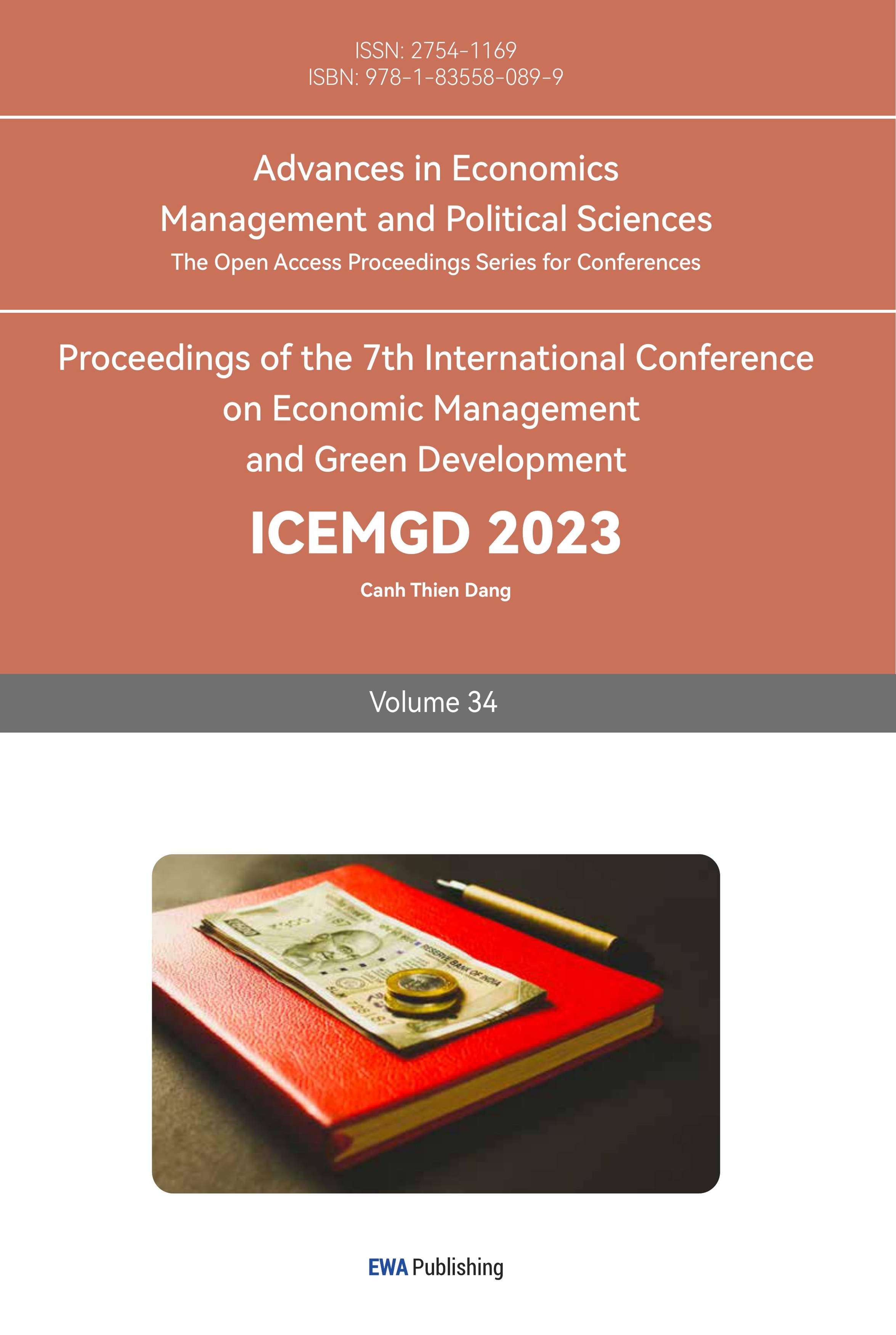References
[1]. The Sveriges Riksbank Prize in Economic Sciences in Memory of Alfred Nobel 2022. Nobel Prize org. https://www.nobelprize.org/prizes/economic-sciences/2022/prize-announcement/, last accessed 2023/04/05.
[2]. Lin, J., & Treichel, V.: The Unexpected Global Financial Crisis: Researching Its Root Cause. World Bank Policy Research Working Paper (2012).
[3]. Sanders, A. B.: The subprime crisis and its role in the financial crisis. Journal of Housing Economics, 17(4), 254–261 (2008).
[4]. Murphy, A.: An Analysis of the Financial Crisis of 2008: Causes and Solutions. Social Science Research Network (2008).
[5]. Financial crisis of 2007-08: Definition, Causes, Effects, & Facts. Encyclopedia Britannica. https://www.britannica.com/event/financial-crisis-of-2007-2008/Key-events-of-the-crisis, last accessed 2023/03/15.
[6]. Lipscy, P. Y., & Takinami, H.: The Politics of Financial Crisis Response in Japan and the United States. Japanese Journal of Political Science, 14(3), 321–353 (2013).
[7]. Dodd-Frank Act: What It Does, Major Components, Criticisms. Investopedia. https://www.investopedia.com/terms/d/dodd-frank-financial-regulatory-reform-bill.asp, last accessed 2023/03/15.
[8]. Acharya, V. V., & Richardson, M.: Implications of the Dodd-Frank Act. Annual Review of Financial Economics, 4, 1–38 (2012).
[9]. Basel III: What It Is, Capital Requirements, and Implementation. Investopedia. https://www.investopedia.com/terms/b/basell-iii.asp, last accessed 2023/03/15.
[10]. Hartlage, A. W.: The Basel III Liquidity Coverage Ratio and Financial Stability. Michigan Law Review, 111(3), 453–483 (2012).
Cite this article
Xiao,S. (2023). Too Big to Fail: An Analysis of Systemic Risk in the 2008 Financial Crisis. Advances in Economics, Management and Political Sciences,34,146-152.
Data availability
The datasets used and/or analyzed during the current study will be available from the authors upon reasonable request.
Disclaimer/Publisher's Note
The statements, opinions and data contained in all publications are solely those of the individual author(s) and contributor(s) and not of EWA Publishing and/or the editor(s). EWA Publishing and/or the editor(s) disclaim responsibility for any injury to people or property resulting from any ideas, methods, instructions or products referred to in the content.
About volume
Volume title: Proceedings of the 7th International Conference on Economic Management and Green Development
© 2024 by the author(s). Licensee EWA Publishing, Oxford, UK. This article is an open access article distributed under the terms and
conditions of the Creative Commons Attribution (CC BY) license. Authors who
publish this series agree to the following terms:
1. Authors retain copyright and grant the series right of first publication with the work simultaneously licensed under a Creative Commons
Attribution License that allows others to share the work with an acknowledgment of the work's authorship and initial publication in this
series.
2. Authors are able to enter into separate, additional contractual arrangements for the non-exclusive distribution of the series's published
version of the work (e.g., post it to an institutional repository or publish it in a book), with an acknowledgment of its initial
publication in this series.
3. Authors are permitted and encouraged to post their work online (e.g., in institutional repositories or on their website) prior to and
during the submission process, as it can lead to productive exchanges, as well as earlier and greater citation of published work (See
Open access policy for details).
References
[1]. The Sveriges Riksbank Prize in Economic Sciences in Memory of Alfred Nobel 2022. Nobel Prize org. https://www.nobelprize.org/prizes/economic-sciences/2022/prize-announcement/, last accessed 2023/04/05.
[2]. Lin, J., & Treichel, V.: The Unexpected Global Financial Crisis: Researching Its Root Cause. World Bank Policy Research Working Paper (2012).
[3]. Sanders, A. B.: The subprime crisis and its role in the financial crisis. Journal of Housing Economics, 17(4), 254–261 (2008).
[4]. Murphy, A.: An Analysis of the Financial Crisis of 2008: Causes and Solutions. Social Science Research Network (2008).
[5]. Financial crisis of 2007-08: Definition, Causes, Effects, & Facts. Encyclopedia Britannica. https://www.britannica.com/event/financial-crisis-of-2007-2008/Key-events-of-the-crisis, last accessed 2023/03/15.
[6]. Lipscy, P. Y., & Takinami, H.: The Politics of Financial Crisis Response in Japan and the United States. Japanese Journal of Political Science, 14(3), 321–353 (2013).
[7]. Dodd-Frank Act: What It Does, Major Components, Criticisms. Investopedia. https://www.investopedia.com/terms/d/dodd-frank-financial-regulatory-reform-bill.asp, last accessed 2023/03/15.
[8]. Acharya, V. V., & Richardson, M.: Implications of the Dodd-Frank Act. Annual Review of Financial Economics, 4, 1–38 (2012).
[9]. Basel III: What It Is, Capital Requirements, and Implementation. Investopedia. https://www.investopedia.com/terms/b/basell-iii.asp, last accessed 2023/03/15.
[10]. Hartlage, A. W.: The Basel III Liquidity Coverage Ratio and Financial Stability. Michigan Law Review, 111(3), 453–483 (2012).









